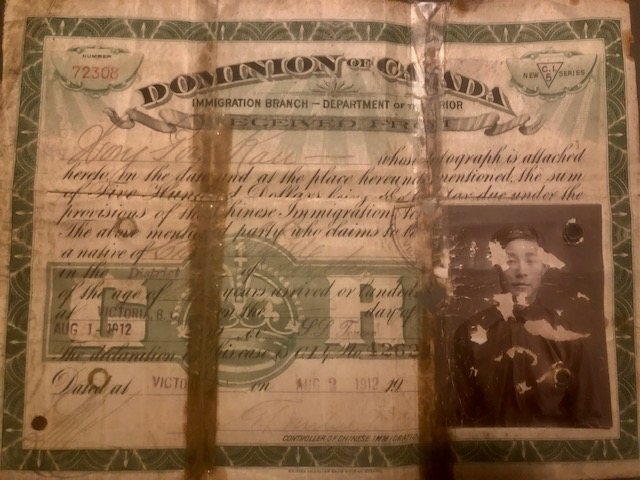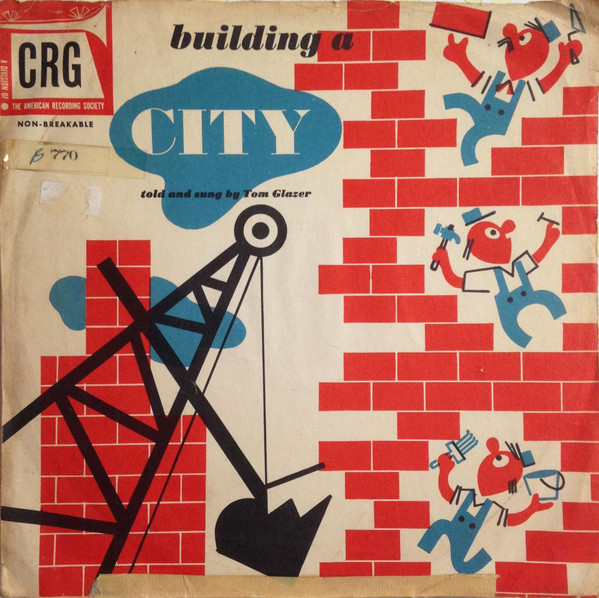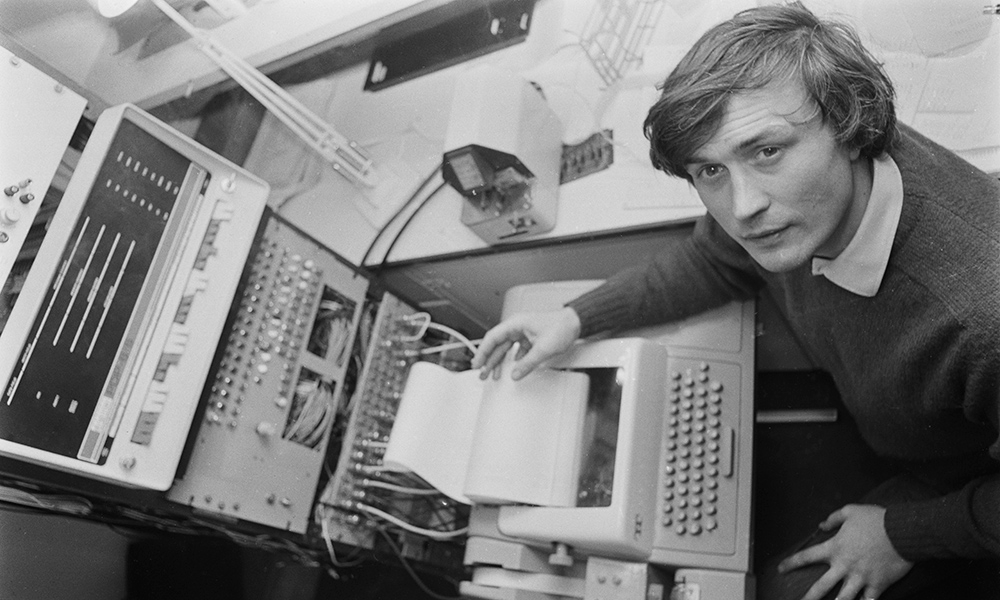
This appears on what would have been the 90th birthday of Peter Zinovieff, (1933-01-26 – 2021-06-23) composer, hesitant engineer and reluctant synthesist.
There are some elements to Zinovieff’s life, that only happen because of his Russian aristocractic background. In 1960, Zinovieff married Victoria Heber-Percy (1943 – ). Her tiara was auctioned, to finance Zinovieff’s first computer. This was used to control an array of oscillators and amplifiers he had bought from an army surplus store. He claims that this was the first computer in the world in a private house. I am uncertain what benefits Heber-Percy got out of the sale of her tiara, but the marriage did not last.
Zinovieff closely followed some developments in computing related to sound generation. In particular this was happening at Bell Labs in New Jersey, where its owners had a vested interest in telephone research. There in 1957, Max Mathews (1926 – 2011) had written MUSIC, the first widely used program for sound generation. This had been further developed in the 1960s with new versions. In 1964, Jean-Claude Risset (1938 – 2016), had used MUSIC IV software to digitally recreate the sounds of brass instruments. He made digital recordings of trumpets and studied their timbral composition using pitch-synchronous spectrum analysis tools.
In 1963, David Alan Luce’s (1936 – 2017) doctoral research at the Massachusetts Institute of Technology implemented a pitch-synchronous approach to analysis/resynthesis of instrumental tones. Luce joined Moog Music in 1972, where he developed a polyphonic synthesizer, the Polymoog. Later, he became head of engineering, then president of Moog in 1981. He became a co-owner in 1984. Moog Music closed in 1987.
In 1966–67, Zinovieff, Delia Derbyshire (1937 – 2001) and Brian Hodgson (1938 – ) ran Unit Delta Plus, creating electronic music. Its studio was built by Zinovieff in a shed at his house in Putney, Greater London. Unit Delta Plus had a short life, and was disbanded in 1967.
Zinovieff worked with a medical technician with electrical engineering skills, David Cockerell (? – ) and software engineer Peter Grogono (1944 – 2021) to develop an analogue–digital (hybrid) performance controller. Grogono was tasked with developing a new musical composition and sequencing language, MUSYS, that was to be easy to use (composer friendly) and efficient, and working within the limitations of two Digital Equipment PDP8/S and PDP8/L older and newer computers, respectively, named Sofka and Leo, after Zinovieff’s two first children. The system saved output data files to disk. A musical keyboard was added for input, as an afterthought.
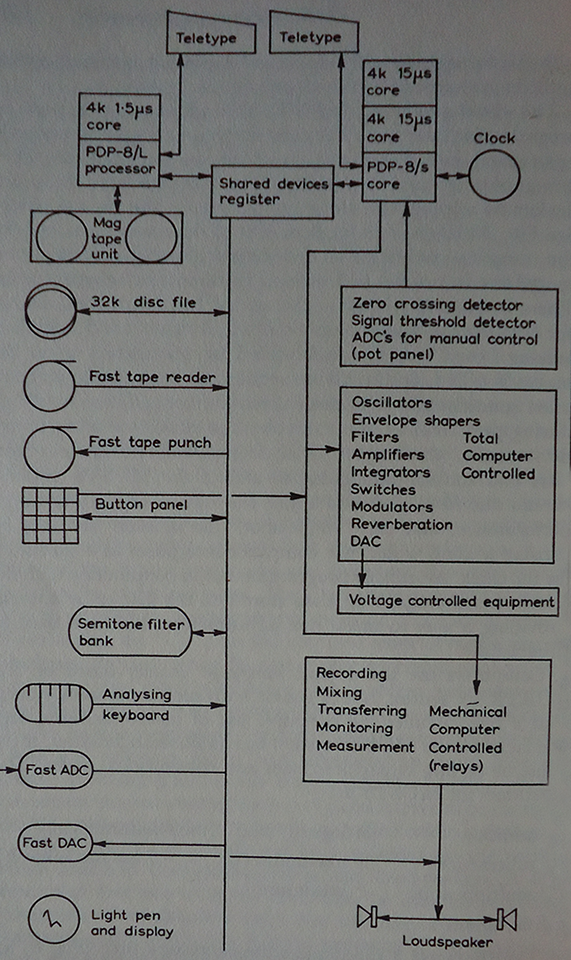
In the mid-1960s electronic components were expensive, and the equipment being made exceeded Zinovieff’s means. Thus, it was decided to sell some machines to finance further development costs. Zinovieff, Cockerell and composer Tristram Cary (1925 – 2008) founded Electronic Music Studios (EMS). It is likely that the name was selected for this enterprise prioritizing a studio making music, while ignoring a product manufacturer making synths. EMS created a commercial, miniaturised version of its studio as a modular, affordable synthesizer for the education market. A prototype called the Voltage Controlled Studio 1 (VCS1) was designed by David Cockerell, consisting of a two oscillator instrument built into a wooden rack unit, and built for the Australian composer Don Banks (1923 – 1990) for £50, after a lengthy pub conversation.
Some of this equipment was subsequently marketed as a synthesizer system using the EMS label. It was considerably more portable than the existing Moog system. Possibly because Robert Moog recognized the limitations of his synthesizers, he offered to sell out to EMS for one million dollars. Zinovieff turned down this offer.
The EMS Synthi 100 was a large analogue/digital hybrid synthesizer series, of which 30 were produced. The first unit was orriginally a custom order from Radio Belgrade for its Radio Belgrade Electronic Studio. This order was the result of contact between composer/ saxophonist Paul Pignon (1939 – ), then living in Belgrade, and Zinovieff. The synthesiser was designed by David Cockerell who documented it in detail in 1971. The cost at that time was £ 6 500.
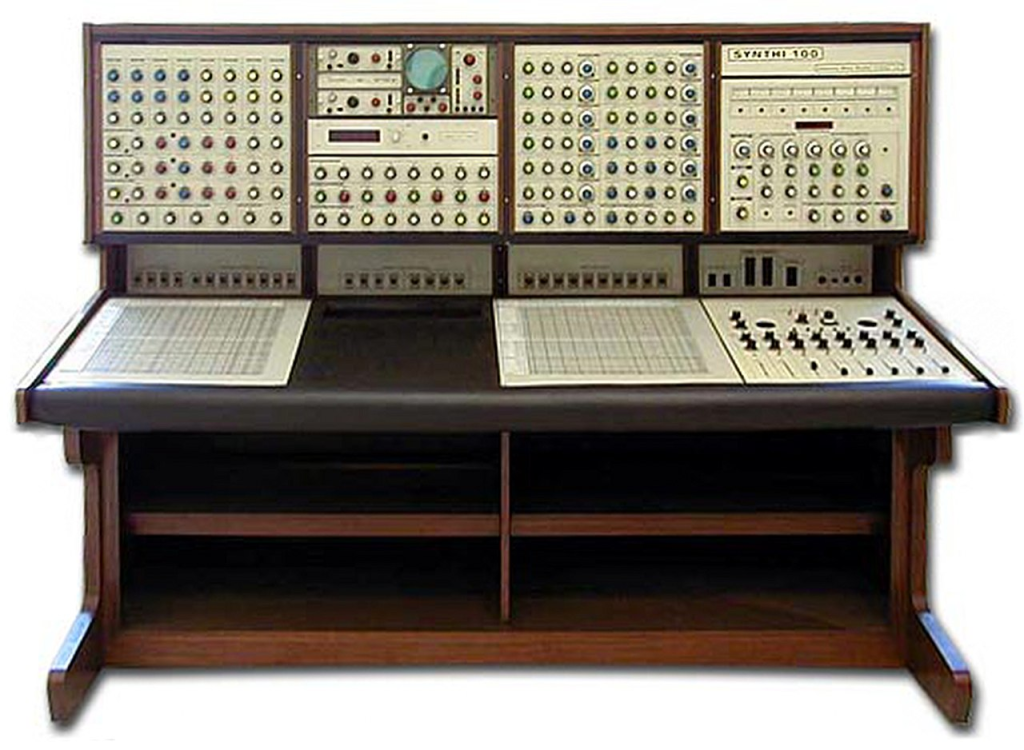
While EMS lasted until 1979, its key personnel soon began leaving the company. Cockerell left in 1972 to join Electro-Harmonix to design effect pedals. Cary left in 1973 to become Professor of Electronic Music at the Royal College of Music and later Professor of Music at the University of Adelade. Grogono left in 1973 but continued working on the MUSYS programming language and further developed it into the Mouse language. He became a computer science professor at Concordia University in Montreal, Canada.
The main challenge for Zinovieff was his aristocratic origins, that prevented him from doing technical work. In 2019 he commented on EMS as a business: “It’s always been a problem with me because I don’t like synthesizers. So this side of EMS was never interesting to me, it was always the studio. The basic purpose of EMS was to finance the studio, but unfortunately that’s not what happened. EMS got bigger and bigger and we made more and more products and it took up more time. And instead of making money, it started to lose it. In the end, when EMS went bankrupt, it pulled the studio down.”
Zinovieff then closed the Putney studio, which was sold to the National Theatre. The equipment was put into storage, and later destroyed in a flood.
He then moved to the remote Scottish island of Raasay between 1975 and 1983. His cottage had no mains electricity supply, so synths were powered by wind generation that charged batteries.
He then move to Cambridge where, in the 1980s, he received two commissions from Clive Sinclair (1940 – 2021) including a piano-sampling project and consultations on sound support for the Sinclair QL personal computer, launched in 1984.
Zinovieff as Composer
In 1968, Zinovieff staged the world premiere of Partita for Unattended Computer, notable for being the first ever unaccompanied performance of live computer music, with no human performer involved, with the piece read from paper tape.
Later in 1968, as part of Cybernetic Serendipity, the first UK international exhibition devoted to the relationship between the arts and new technology, Zinovieff et al created a computer system, that could analyse a tune whistled by a visitor to the show and improvise upon it.
Zinovieff collaborated with Harrison Birtwistle (1934 – 2022) on Chronometer (1971–2) with recordings of Big Ben ticking, and Wells Cathedral clock chiming. Zinovieff claimed that in this project he had invented the technique of musical sampling.
The soundtrack for Sidney Lumet’s (1924 – 2011) film The Offence (1972) was composed by Birtwistle with electronic realization by Zinovieff.
Zinovieff also wrote the words for Birtwistle’s Nenia: The Death of Orpheus (1970) for soprano, 3 bass clarinets, crotales and piano. Here the electronic realization was by Barry Anderson (1935 – 1987). Zinovieff wrote the libretto for Birtwistle’s opera The Mask of Orpheus (1973-84).
He also worked with Hans Werner Henze (1926 – 2012) producing a tape in Tristan’s Folly in Tristan (1975).
Through an association with Francesca Thyssen-Bornemisza (1964 – ), Zinovieff was able to create an audio work for a large-scale installation, The Morning Line by Matthew Ritchie (1964 – ), Bridges from Somewhere and Another to Somewhere Else (2011). Good Morning Ludwig (2012) followed.
Following these projects, Zinovieff’s compositions typically combined sounds from live instrumentation and field recordings and multi-channel performances.
He collaborated with Kazakhstani violinist Aisha Orazbayeva (1985 – ), composing two concertos for violin and electronics: OUR (2010) and Our Too (2014).
From 2011 he collaborated with Scottish poet, historian and broadcaster Katrina Porteous (1960 – ) to combine her poetry with soundscapes created by Zinovieff using sound sources related to physics and astronomy. This resulted in Horse (2011), then with the Planetarium at the Centre for Life, Newcastle upon Tyne, Edge (2013), Field (2015) and Sun (2016). Live visuals for these last works were created by planetarium supervisor Christopher Hudson.
A retrospective compilation of Zinovieff’s work in the EMS era was compiled by English musician Pete Kember/ Sonic Boom (1965 – ) and released in 2015.
Zinovieff collaborated with cellist Lucy Railton (? – ) on RFG (2016). An album version was released as RFG Inventions for Cello and Computer (2020).
Between the years 2013–2017, Zinovieff composed South Pacific Migration Party, based on from hydrophone recordings of blue whales recorded by British oceanographer Susannah Buchan off the coast of Chile. In was released on the record label The Association for Depth Sound Recordings in 2021.
Zinovieff’s final work was, Under The Ice (2021), a 30-minute piece based on recordings of Antarctic glaciers.


